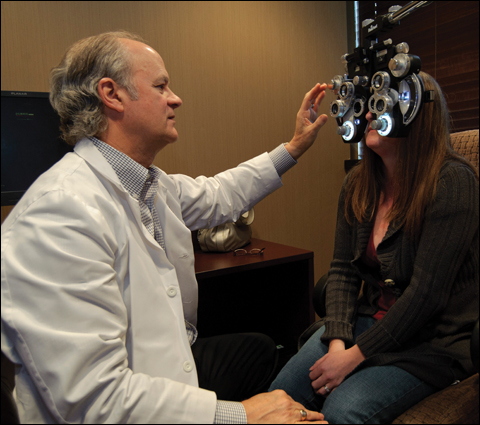Scope of refractive surgery blooms beyond simply LASIK
Click Here to Manage Email Alerts
Refractive surgery is not just LASIK surgery anymore.
Surgeons who want to be true refractive surgeons and help patients see better without glasses or contact lenses now have more opportunities than ever to obtain good outcomes using a variety of refractive procedures — seven in all.
“If you are a lead refractive surgeon, you better know all seven procedures and who is a candidate for each one,” OSN Refractive Surgery Section Editor Daniel S. Durrie, MD, said.

Image: Kenny Johnson Photography
PRK was first performed in 1987, and LASIK was approved by the FDA in 1999. The field of refractive surgery also now includes phakic IOLs, refractive lens exchange (RLE), corneal inlays, small incision lenticule extraction (SMILE) and corneal cross-linking.
“It’s just an amazing time now to be a refractive surgeon,” Durrie said. “Through a tremendous amount of development and the introduction of lasers, computers, outcomes analysis and especially diagnostic equipment, patients interested in seeing better than with glasses and contact lenses can now have sophisticated diagnostic tests and evaluation to find out if they are truly good candidates for refractive procedures, and if they are, determine which of the seven procedures they qualify for.”
Furthermore, in many cases, patients have fewer dry eye symptoms and night vision problems than they experienced with contact lenses, Durrie said.
FDA approvals spawn growth
Several significant FDA approvals for refractive surgery have occurred over the past 3 years, after a hiatus of more than a decade, and have affirmed the safety and efficacy of these procedures and boosted growth in the refractive surgery space.
In 2015, the Visx Star S4 IR excimer laser was FDA approved to treat myopia and astigmatism with the iDesign Advanced WaveScan Studio system and the CustomVue procedure. Both systems are from Abbott Medical Optics.
Then, in November 2016, the iDesign system was approved for treating mixed astigmatism.
“Not only did the clinical trial for each of these two approvals show that LASIK was safe and effective, but patients also reported improved symptoms of dry eye, night vision, halos and glare,” Durrie said.
In addition, Alcon/Novartis introduced the WaveLight platform Contoura Vision System for topography-guided custom ablation treatment in November 2015; the technology had garnered FDA approval in 2013.
“That clinical trial also demonstrated that patients reported better outcomes after surgery than before,” Durrie said.
These three FDA approvals “fit the overall narrative of modern laser surgery,” according to Durrie, who added that software for these technologies has now been upgraded to produce even better diagnostics and outcomes.
“We have learned who are the very best candidates for surgery,” Durrie said. Patients should have healthy eyes and stable vision. They should be motivated. And they should be well educated about the procedure. Surgical candidates who are younger than 30 years now represent the prime growth area for refractive surgery, he said.
- Click here to read the full publication exclusive, Cover story, published in Ocular Surgery News U.S. Edition, February 10, 2017.
